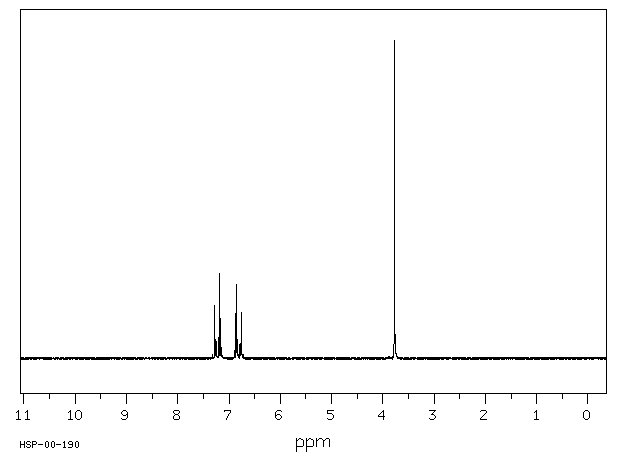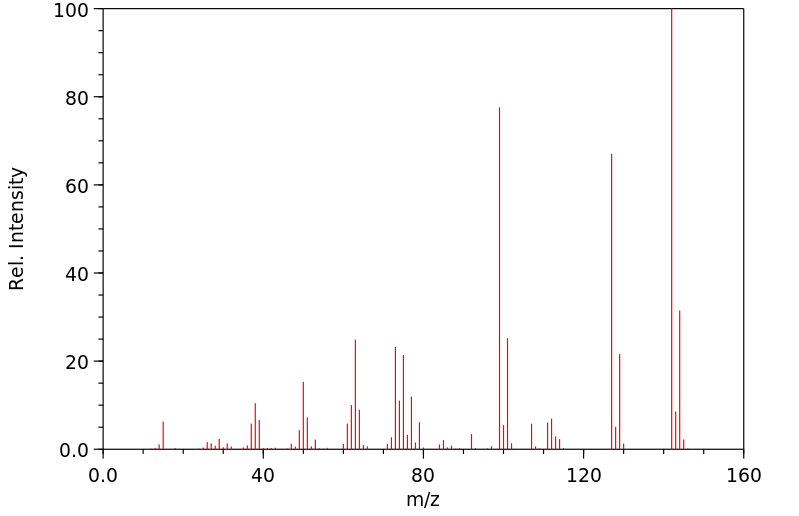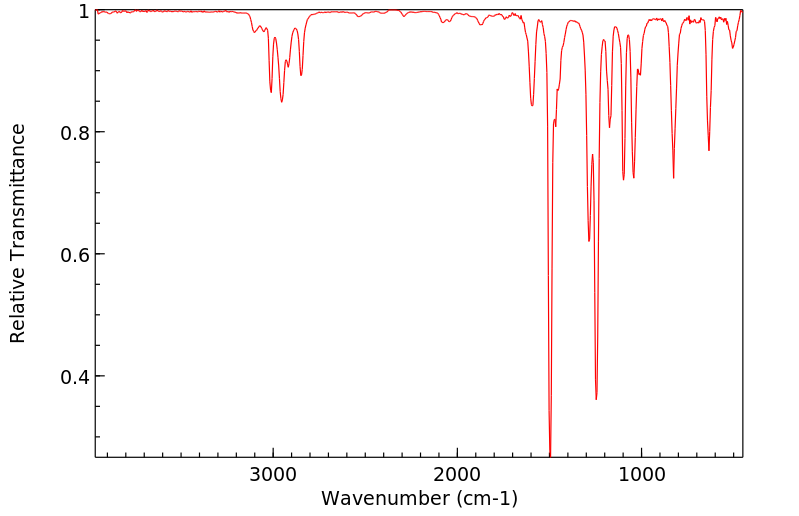4-氯苯甲醚 | 623-12-1
-
物化性质
-
计算性质
-
ADMET
-
安全信息
-
SDS
-
制备方法与用途
-
上下游信息
-
文献信息
-
表征谱图
-
同类化合物
-
相关功能分类
-
相关结构分类
物化性质
-
熔点:-18 °C (lit.)
-
沸点:198-202 °C (lit.)
-
密度:1.164 g/mL at 25 °C (lit.)
-
闪点:173 °F
-
LogP:2.78 at 25℃
-
溶解度:0.00 M
-
保留指数:1079.5;1082;1090;1093;1090;1094;1108;1077
-
稳定性/保质期:
远离氧化物。
计算性质
-
辛醇/水分配系数(LogP):2.8
-
重原子数:9
-
可旋转键数:1
-
环数:1.0
-
sp3杂化的碳原子比例:0.142
-
拓扑面积:9.2
-
氢给体数:0
-
氢受体数:1
安全信息
-
TSCA:Yes
-
危险品标志:Xn
-
安全说明:S23,S24/25
-
WGK Germany:3
-
海关编码:29093090
-
危险品运输编号:UN 2810
-
危险性防范说明:P261,P305+P351+P338
-
危险性描述:H315,H319,H335
-
储存条件:存放在密封容器中,并置于阴凉、干燥处。请确保存储地点远离氧化剂。
SDS
| Name: | 4-Chloroanisole 99% Material Safety Data Sheet |
| Synonym: | 1-Chloro-4-Methoxybenzene |
| CAS: | 623-12-1 |
Synonym:1-Chloro-4-Methoxybenzene
Section 2 - COMPOSITION, INFORMATION ON INGREDIENTS
| CAS# | Chemical Name | content | EINECS# |
| 623-12-1 | 4-Chloroanisole | 99% | 210-772-2 |
Risk Phrases: None Listed.
Section 3 - HAZARDS IDENTIFICATION
EMERGENCY OVERVIEW
Not available.
Potential Health Effects
Eye:
May cause eye irritation. May cause chemical conjunctivitis and corneal damage.
Skin:
May cause irritation and dermatitis. May cause cyanosis of the extremities.
Ingestion:
May cause gastrointestinal irritation with nausea, vomiting and diarrhea. May cause central nervous system depression.
Inhalation:
May cause respiratory tract irritation. Aspiration may lead to pulmonary edema. Inhalation at high concentrations may cause CNS depression and asphixiation.
Chronic:
Effects may be delayed.
Section 4 - FIRST AID MEASURES
Eyes: Immediately flush eyes with plenty of water for at least 15 minutes, occasionally lifting the upper and lower eyelids. Get medical aid.
Skin:
Get medical aid. Flush skin with plenty of water for at least 15 minutes while removing contaminated clothing and shoes. Wash clothing before reuse.
Ingestion:
Never give anything by mouth to an unconscious person. Get medical aid. Do NOT induce vomiting. If conscious and alert, rinse mouth and drink 2-4 cupfuls of milk or water.
Inhalation:
Remove from exposure and move to fresh air immediately. If breathing is difficult, give oxygen. Get medical aid. Do NOT use mouth-to-mouth resuscitation. If breathing has ceased apply artificial respiration using oxygen and a suitable mechanical device such as a bag and a mask.
Notes to Physician:
Section 5 - FIRE FIGHTING MEASURES
General Information:
As in any fire, wear a self-contained breathing apparatus in pressure-demand, MSHA/NIOSH (approved or equivalent), and full protective gear. During a fire, irritating and highly toxic gases may be generated by thermal decomposition or combustion. Use water spray to keep fire-exposed containers cool. Combustible liquid.
Vapors may be heavier than air. They can spread along the ground and collect in low or confined areas. Containers may explode when heated.
Runoff from fire control or dilution water may cause pollution.
Extinguishing Media:
Use water spray to cool fire-exposed containers. Use agent most appropriate to extinguish fire. Use water spray, dry chemical, carbon dioxide, or appropriate foam.
Section 6 - ACCIDENTAL RELEASE MEASURES
General Information: Use proper personal protective equipment as indicated in Section 8.
Spills/Leaks:
Absorb spill with inert material (e.g. vermiculite, sand or earth), then place in suitable container. Avoid runoff into storm sewers and ditches which lead to waterways. Clean up spills immediately, observing precautions in the Protective Equipment section. Remove all sources of ignition. Use a spark-proof tool. Provide ventilation.
Section 7 - HANDLING and STORAGE
Handling:
Wash thoroughly after handling. Remove contaminated clothing and wash before reuse. Use with adequate ventilation. Avoid contact with eyes, skin, and clothing. Empty containers retain product residue, (liquid and/or vapor), and can be dangerous. Keep container tightly closed. Keep away from heat, sparks and flame. Avoid ingestion and inhalation. Do not pressurize, cut, weld, braze, solder, drill, grind, or expose empty containers to heat, sparks or open flames.
Storage:
Keep away from sources of ignition. Store in a tightly closed container. Store in a cool, dry, well-ventilated area away from incompatible substances.
Section 8 - EXPOSURE CONTROLS, PERSONAL PROTECTION
Engineering Controls:
Facilities storing or utilizing this material should be equipped with an eyewash facility and a safety shower. Use adequate ventilation to keep airborne concentrations low.
Exposure Limits CAS# 623-12-1: Personal Protective Equipment Eyes: Wear appropriate protective eyeglasses or chemical safety goggles as described by OSHA's eye and face protection regulations in 29 CFR 1910.133 or European Standard EN166.
Skin:
Wear appropriate protective gloves to prevent skin exposure.
Clothing:
Wear appropriate protective clothing to prevent skin exposure.
Respirators:
Follow the OSHA respirator regulations found in 29 CFR 1910.134 or European Standard EN 149. Use a NIOSH/MSHA or European Standard EN 149 approved respirator if exposure limits are exceeded or if irritation or other symptoms are experienced.
Section 9 - PHYSICAL AND CHEMICAL PROPERTIES
Physical State: Liquid
Color: light yellow or yellow
Odor: None reported.
pH: Not available.
Vapor Pressure: Not available.
Viscosity: Not available.
Boiling Point: 198 - 202 deg C @ 760.00mmHg
Freezing/Melting Point: 18 deg C
Autoignition Temperature: Not applicable.
Flash Point: 78 deg C ( 172.40 deg F)
Explosion Limits, lower: Not available.
Explosion Limits, upper: Not available.
Decomposition Temperature:
Solubility in water: immiscible
Specific Gravity/Density: 1.1640g/cm3
Molecular Formula: C7H7ClO
Molecular Weight: 142.58
Section 10 - STABILITY AND REACTIVITY
Chemical Stability:
Stable under normal temperatures and pressures.
Conditions to Avoid:
Incompatible materials, ignition sources, excess heat, strong oxidants.
Incompatibilities with Other Materials:
Oxidizing agents.
Hazardous Decomposition Products:
Hydrogen chloride, carbon monoxide, irritating and toxic fumes and gases, carbon dioxide.
Hazardous Polymerization: Has not been reported.
Section 11 - TOXICOLOGICAL INFORMATION
RTECS#:
CAS# 623-12-1 unlisted.
LD50/LC50:
Not available.
Carcinogenicity:
4-Chloroanisole - Not listed by ACGIH, IARC, or NTP.
Section 12 - ECOLOGICAL INFORMATION
Section 13 - DISPOSAL CONSIDERATIONS
Dispose of in a manner consistent with federal, state, and local regulations.
Section 14 - TRANSPORT INFORMATION
IATA
Not regulated as a hazardous material.
IMO
Not regulated as a hazardous material.
RID/ADR
Not regulated as a hazardous material.
Section 15 - REGULATORY INFORMATION
European/International Regulations
European Labeling in Accordance with EC Directives
Hazard Symbols: Not available.
Risk Phrases:
Safety Phrases:
S 24/25 Avoid contact with skin and eyes.
S 28A After contact with skin, wash immediately with
plenty of water.
S 37 Wear suitable gloves.
S 45 In case of accident or if you feel unwell, seek
medical advice immediately (show the label where
possible).
WGK (Water Danger/Protection)
CAS# 623-12-1: No information available.
Canada
CAS# 623-12-1 is listed on Canada's NDSL List.
CAS# 623-12-1 is not listed on Canada's Ingredient Disclosure List.
US FEDERAL
TSCA
CAS# 623-12-1 is listed on the TSCA inventory.
SECTION 16 - ADDITIONAL INFORMATION
N/A
制备方法与用途
上下游信息
-
上游原料
中文名称 英文名称 CAS号 化学式 分子量 对氯苯酚 4-chloro-phenol 106-48-9 C6H5ClO 128.558 3,4-二氯苯甲醚 3,4-dichloroanisole 36404-30-5 C7H6Cl2O 177.03 2,4-二氯苯甲醚 1,3-dichloro-4-methoxybenzene 553-82-2 C7H6Cl2O 177.03 苯甲醚 methoxybenzene 100-66-3 C7H8O 108.14 3,5-二氯苯甲醚 3,5-dichloroanisole 33719-74-3 C7H6Cl2O 177.03 2,4,6-三氯苯甲醚 2,4,6-trichloroanisole 87-40-1 C7H5Cl3O 211.475 4-甲氧基苯酚 4-methoxy-phenol 150-76-5 C7H8O2 124.139 3-溴-4-氯苯甲醚 2-bromo-1-chloro-4-methoxybenzene 2732-80-1 C7H6BrClO 221.481 -
下游产品
中文名称 英文名称 CAS号 化学式 分子量 Alpha,4-二氯茴香醚 p-chlorophenoxymethyl chloride 21151-56-4 C7H6Cl2O 177.03 1-氯-4-(碘甲氧基)苯 4-chloro-α-iodoanisole 106261-89-6 C7H6ClIO 268.482 4-氯苯氧基乙腈 (4-chlorophenoxy)acetonitrile 3598-13-8 C8H6ClNO 167.595 —— 4-chlorophenyl dichloromethyl ether 33104-16-4 C7H5Cl3O 211.475 对氯苯酚 4-chloro-phenol 106-48-9 C6H5ClO 128.558 对氯三氟甲氧基苯 1-chloro-4-(trifluoromethoxy)benzene 461-81-4 C7H4ClF3O 196.556 —— 4-chlorophenyl trichloromethyl ether 16936-56-4 C7H4Cl4O 245.92 乙酸-4-氯苯酯 4-chlorophenyl acetate 876-27-7 C8H7ClO2 170.595 2,4-二氯苯甲醚 1,3-dichloro-4-methoxybenzene 553-82-2 C7H6Cl2O 177.03 5-氯-2-甲氧基-苯酚 5-chloro-2-methoxyphenol 3743-23-5 C7H7ClO2 158.584 苯甲醚 methoxybenzene 100-66-3 C7H8O 108.14 —— 4-methoxybenzyne 76221-91-5 C7H6O 106.124 2,4,6-三氯苯甲醚 2,4,6-trichloroanisole 87-40-1 C7H5Cl3O 211.475 4-氯-2-甲基苯甲醚 2-methyl-4-chloroanisole 3260-85-3 C8H9ClO 156.612 4-甲氧基苯酚 4-methoxy-phenol 150-76-5 C7H8O2 124.139 4-氯-2-氟苯甲醚 4-chloro-2-fluoro-1-methoxybenzene 452-09-5 C7H6ClFO 160.575 对苯二甲醚 1,4-dimethoxybezene 150-78-7 C8H10O2 138.166 5-氯-2-甲氧基苯胺 5-chloro-2-methoxyaniline 95-03-4 C7H8ClNO 157.6 4-氯-2-碘苯甲醚, 4-chloro-2-iodo-1-methoxybenzene 52807-27-9 C7H6ClIO 268.482 2-溴-4-氯苯甲醚 2-bromo-4-chloroanisole 60633-25-2 C7H6BrClO 221.481 - 1
- 2
反应信息
-
作为反应物:描述:4-氯苯甲醚 在 aluminum tri-bromide 、 硝酸 、 magnesium 、 zinc(II) chloride 、 苯 作用下, 生成 5,5'-dichloro-3,3'-dinitro-bibenzyl-2,2'-diol参考文献:名称:Pfleger; Waldmann, Chemische Berichte, 1957, vol. 90, p. 2395,2399摘要:DOI:
-
作为产物:描述:4,4'-Dimethoxydiphenyliodonium chloride 以 氘代苯 为溶剂, 反应 120.0h, 以100%的产率得到4-氯苯甲醚参考文献:名称:[EN] RADIOIODINATED COMPOUNDS
[FR] COMPOSÉS RADIOIODÉS摘要:公开号:WO2015147950A3 -
作为试剂:描述:4-乙酰基苯甲酸甲酯 在 potassium fluoride 、 4-氯苯甲醚 、 palladium diacetate 作用下, 以 四氢呋喃 、 水 为溶剂, 反应 1.0h, 以52%的产率得到4-乙基苯甲酸甲酯参考文献:名称:氯芳烃公司Pd-PMHS纳米颗粒催化CO氢解摘要:催化 Pd(OAc) 2和聚甲基氢硅氧烷 (PMHS) 与水性 KF 和催化量的芳族氯化物结合,在室温下在 THF 中影响苄基氧化底物的化学、区域和立体选择性脱氧。初步的机械实验表明该过程涉及钯-纳米颗粒催化的氢化硅烷化,然后是 CO 还原。氯芳烃添加剂似乎通过 HCl 的缓慢受控释放促进氢解过程。DOI:10.1021/ol102757v
文献信息
-
Nickel(II) N‐Heterocyclic Carbene Complexes: Versatile Catalysts for C–C, C–S and C–N Coupling Reactions作者:Lourdes Benítez Junquera、Francys E. Fernández、M. Carmen Puerta、Pedro ValergaDOI:10.1002/ejic.201700057日期:2017.5.18A variety of Ni(II) complexes with a wide range of electronic and steric properties, bearing picolyl-imidazolidene ligands (a-g) and Cp (2a-f) or Cp* (3a,c,g) groups, have been synthesised and characterised using NMR and single crystal X-ray crystallography. The complexes have been used as precatalysts for a wide range of catalytic transformations most likely involving a Ni0/NiII catalytic cycle. In
-
[EN] SUBSTITUTED QUINAZOLINES AS FUNGICIDES<br/>[FR] QUINAZOLINES SUBSTITUÉES, UTILISÉES EN TANT QUE FONGICIDES申请人:SYNGENTA PARTICIPATIONS AG公开号:WO2010136475A1公开(公告)日:2010-12-02The present invention relates to a compound of formula (I) wherein wherein the substituents have the definitions as defined in claim 1or a salt or a N-oxide thereof, their use and methods for the control and/or prevention of microbial infection, particularly fungal infection, in plants and to processes for the preparation of these compounds.本发明涉及一种具有如下式(I)的化合物,其中取代基具有权利要求1中定义的定义,或其盐或N-氧化物,它们的用途以及用于控制和/或预防植物中微生物感染,特别是真菌感染的方法,以及制备这些化合物的方法。
-
[EN] ROR-GAMMA INHIBITORS<br/>[FR] INHIBITEURS DE ROR-GAMMA申请人:GLAXOSMITHKLINE IP DEV LTD公开号:WO2019063748A1公开(公告)日:2019-04-04The present invention relates to compounds of formula I and pharmaceutical compositions comprising compounds of formula I. Compounds of Formula I are useful in treatment of inflammatory, metabolic or autoimmune diseases which are mediated by RORy.本发明涉及公式I的化合物和包含公式I化合物的药物组合物。公式I的化合物在治疗由RORγ介导的炎症性、代谢性或自身免疫性疾病方面是有用的。
-
Selective Dehydrocoupling of Phosphines by Lithium Chloride Carbenoids作者:Sebastian Molitor、Julia Becker、Viktoria H. GessnerDOI:10.1021/ja509381w日期:2014.11.5for the formation of phosphorus-phosphorus bonds through dehydrocoupling of phosphines is presented. The reaction is mediated by electronically stabilized lithium chloride carbenoids and affords a variety of different diphosphines under mild reaction conditions. The developed protocol is simple and highly efficient and allows the isolation of novel functionalized diphosphines in high yields.
-
A European Perspective on Depression in the Community: The DEPRES Study作者:Saena Arbabzadeh-Bouchez、Andre Tylee、Jean-Pierre LépineDOI:10.1017/s1092852900017430日期:2002.2
ABSTRACT Depression is one of the most prevalent disorders in the general population, causing personal and social disability and impairment. Major studies assessing the diagnosis and management of depression have shown that it is often underdiagnosed and undertreated. A pan-European study aimed at assessing the extent and consequences of depression in six different countries is reported in this article. Different types of depressive profiles are analyzed and their respective management has been compared. The importance of improving diagnosis and treatment of depression is underlined. Appropriate management of depression depends on the recognition of depressive symptoms by patients, their possibility of seeking care, and the ability of the primary care physician to recognize the disorder and prescribe the appropriate medicines. Improvement in all of these fields is necessary.
摘要抑郁症是普通人群中最常见的疾病之一,会造成个人和社会的残疾和损伤。对抑郁症的诊断和管理进行评估的主要研究表明,抑郁症往往诊断不足、治疗不力。本文报告了一项泛欧研究,旨在评估六个不同国家抑郁症的程度和后果。研究分析了不同类型的抑郁症,并对其各自的治疗方法进行了比较。文章强调了改进抑郁症诊断和治疗的重要性。抑郁症的适当治疗取决于患者对抑郁症状的认识、他们寻求治疗的可能性以及初级保健医生识别疾病和开具适当药物的能力。所有这些领域都需要改进。
表征谱图
-
氢谱1HNMR
-
质谱MS
-
碳谱13CNMR
-
红外IR
-
拉曼Raman
-
峰位数据
-
峰位匹配
-
表征信息











